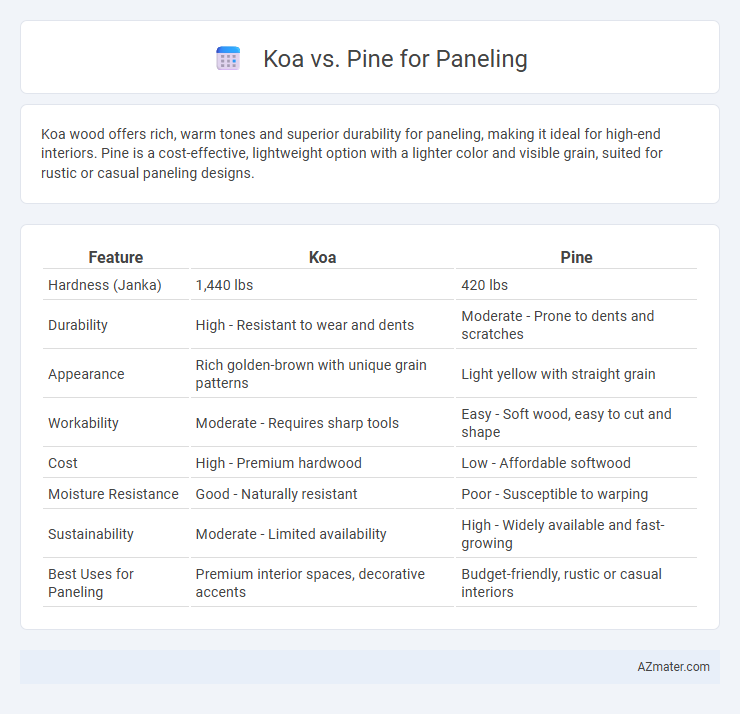Koa wood offers rich, warm tones and superior durability for paneling, making it ideal for high-end interiors. Pine is a cost-effective, lightweight option with a lighter color and visible grain, suited for rustic or casual paneling designs.
Table of Comparison
| Feature | Koa | Pine |
|---|---|---|
| Hardness (Janka) | 1,440 lbs | 420 lbs |
| Durability | High - Resistant to wear and dents | Moderate - Prone to dents and scratches |
| Appearance | Rich golden-brown with unique grain patterns | Light yellow with straight grain |
| Workability | Moderate - Requires sharp tools | Easy - Soft wood, easy to cut and shape |
| Cost | High - Premium hardwood | Low - Affordable softwood |
| Moisture Resistance | Good - Naturally resistant | Poor - Susceptible to warping |
| Sustainability | Moderate - Limited availability | High - Widely available and fast-growing |
| Best Uses for Paneling | Premium interior spaces, decorative accents | Budget-friendly, rustic or casual interiors |
Introduction to Koa and Pine Wood
Koa wood, native to Hawaii, is prized for its rich, warm tones and striking grain patterns, making it a luxurious choice for paneling with a smooth finish and inherent durability. Pine wood, abundant and cost-effective, features a lighter color with a straight grain and is favored for its versatility and ease of staining, suitable for rustic or traditional paneling styles. Both woods offer distinct aesthetics and characteristics, with Koa providing a premium appearance and Pine delivering practical adaptability for interior paneling.
Aesthetic Differences: Koa vs Pine
Koa paneling presents a rich, warm aesthetic with a striking grain pattern and a natural golden to reddish-brown hue, often prized for its luxurious and exotic appearance. Pine paneling offers a lighter, more rustic look with softer knots and a pale yellow tone that ages to a warm amber, making it ideal for casual or country-style interiors. The vibrant and intricate character of Koa contrasts sharply with Pine's understated simplicity, influencing the overall ambiance and style of the space.
Durability and Strength Comparison
Koa wood offers exceptional durability and strength, known for its resistance to wear and environmental factors, making it a premium choice for high-quality paneling. Pine, while more affordable and easier to work with, is softer and less dense, which can lead to more dents and scratches over time. For long-lasting paneling that withstands heavy use and maintains structural integrity, Koa outperforms Pine in both strength and durability metrics.
Cost Factors: Koa vs Pine Paneling
Koa paneling significantly exceeds pine in cost due to its rarity and premium quality, with prices often ranging from $15 to $30 per square foot compared to pine's $2 to $5 range. The labor required for Koa is higher because of its density and grain complexity, affecting installation expenses. In contrast, pine offers cost-effective versatility, making it a budget-friendly option for extensive or large-scale paneling projects.
Environmental Impact and Sustainability
Koa wood, sourced primarily from Hawaii, offers a highly renewable option for paneling due to sustainable forestry practices and its natural resistance to pests, reducing the need for chemical treatments. Pine paneling, often harvested from fast-growing species in managed plantations, provides a lower carbon footprint through rapid regrowth but can involve more intensive processing and chemical use for durability. Choosing Koa supports biodiversity conservation with its native ecosystem benefits, while Pine emphasizes resource efficiency and widespread availability in sustainable timber markets.
Workability and Installation
Koa wood offers exceptional workability due to its fine grain and moderate hardness, making it easy to cut, shape, and finish, which is ideal for precise paneling installations. Pine, known for its softness and lightweight, allows for faster installation and easier handling, though it may require more care to avoid dents and scratches during the process. Both woods provide excellent paneling options, with Koa delivering a more durable and aesthetically rich finish, while pine offers cost-effective simplicity and quicker installation.
Maintenance and Longevity
Koa wood paneling offers superior durability and natural resistance to moisture and insects, requiring minimal maintenance, making it ideal for long-term installations. Pine paneling, while more affordable, is softer and prone to dents and scratches, necessitating regular sealing and upkeep to extend its lifespan. Choosing Koa ensures a longer-lasting, low-maintenance finish compared to the higher maintenance demands of Pine.
Popular Interior Applications
Koa wood offers a luxurious, rich grain pattern with warm reddish-brown tones ideal for high-end interior paneling, commonly featured in living rooms and upscale office spaces. Pine paneling provides a budget-friendly, lightweight option with a natural, rustic appearance, often used in cabins, country-style kitchens, and children's rooms. Both materials are favored for their unique aesthetics and versatility, but Koa is preferred where visual impact and durability are paramount.
Value Addition to Property
Koa wood paneling significantly enhances property value due to its rich, warm tones and natural durability, making interiors both visually striking and long-lasting. Pine paneling offers a cost-effective alternative with its light color and versatility, providing affordable charm and easy customization options. Properties featuring Koa paneling typically attract higher resale values and premium buyers seeking unique, high-quality finishes compared to those with standard Pine paneling.
Choosing the Right Wood for Your Paneling
Koa wood offers rich, warm tones and a smooth finish ideal for luxurious paneling, while pine provides a cost-effective, versatile option with natural knots that add rustic charm. Consider the durability and aesthetic requirements of your space; Koa is dense and resistant to wear, making it suitable for high-traffic areas, whereas pine is softer and easier to work with but may dent more easily. Selecting the right wood depends on balancing budget, desired texture, and long-term maintenance for your paneling project.

Infographic: Koa vs Pine for Paneling
 azmater.com
azmater.com